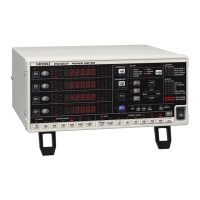2.2 Connecting the Measurement Lines
30
Connecting the measurement lines
Please read "Handling the Instrument" (p.6) carefully before connecting the instru-
ment to the measurement lines.
Connect cables to the instrument’s voltage and current input terminals.
You will need: A Phillips head screwdriver with a No. 3 tip
• Verify that power to the measurement lines has been cut off before connecting the
instrument to them.
• To avoid electric shock or a short-circuit at the input terminals, use solderless termi-
nals that cover wiring with insulation.
• To prevent instrument damage or electric shock, use only the screws (M6
×12 mm)
for securing the voltage input terminals and current input terminals in place and the
screws (M3
×6 mm) for securing the safety cover in place that shipped with the prod-
uct. If you loose any screw or find that any screws are damaged, please contact your
Hioki distributor for a replacement.
Safety covers
• The safety covers play a protective role by preventing contact with the terminals. Always attach the covers
before using the instrument.
• Verify that no voltage is being applied to the measurement lines before attaching or removing the safety
covers.
1
Remove the safety covers from the voltage input terminals and current input terminals.
2
Connect the cables to the voltage input terminals and current input terminals.
3
Attach the safety covers.
Remove the safety cover.
2
Remove the screws. (M3 × 6 mm)
1
Input terminal tight-
ening torque: 3 N
•m
1 Remove the screws with the Phillips head screwdriver.
2 Position each wire as shown in the figure and secure in
place with the screw. (M6 × 12 mm)
Screw
(M6 × 12 mm)
Wire
• Use solderless terminals with a width of 13 mm or less.
• Tighten screws securely.
e.g.) Voltage input terminal
e.g.) Current input terminal
Solderless terminal
(Width 13 mm or less and
capable of accommodat-
ing an M6 screw)
Attach each cover securely.

